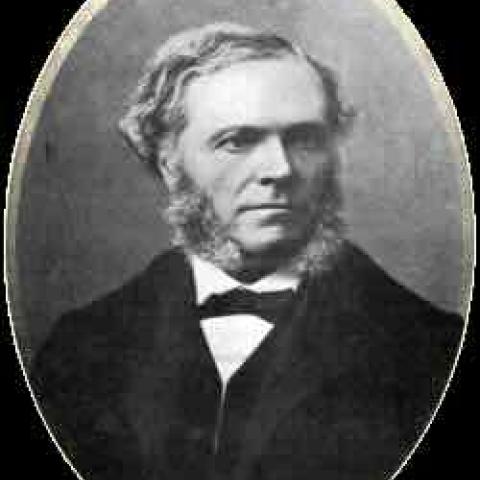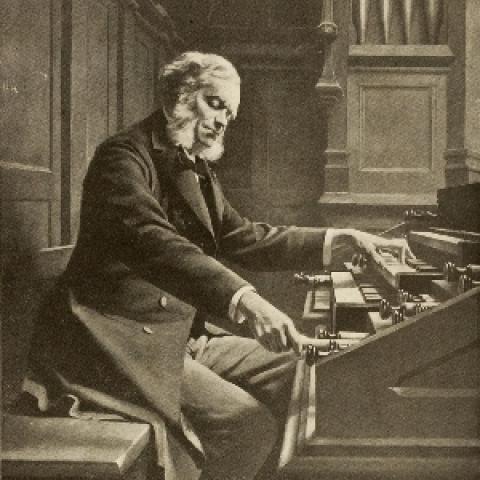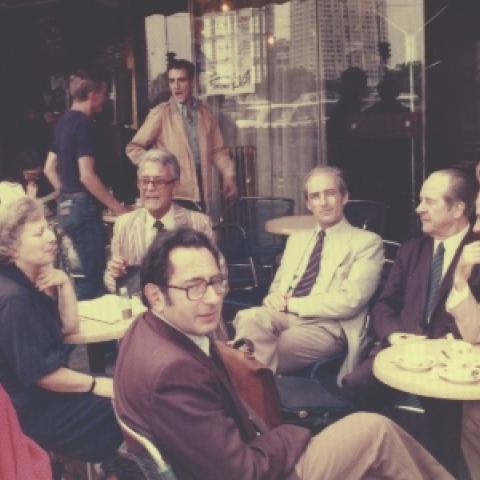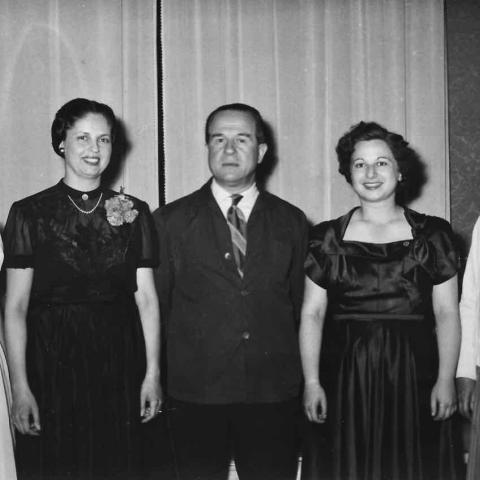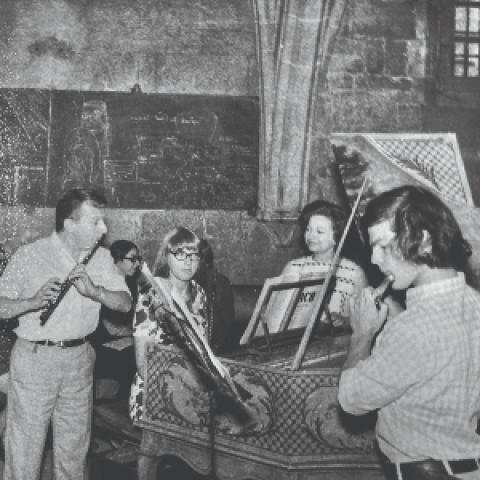Steven Young, DMA, serves as a professor of music at Bridgewater State University, Bridgewater, Massachusetts, where he teaches courses in music theory and conducts the choral ensembles. As an organist, he has recorded selected works of Henry M. Dunham, a Boston-based composer. He has written several articles on the lesser-known organists-composers of France including Charles Quef, Pierre Kunc, and Aloys Claussmann. Young is minister of music/cantor at First Evangelical Lutheran Church of Brockton, Massachusetts.

The name of Marthe Bracquemond is little known in the musical world, yet she was a pioneer as one of the first female organists to break with established expectations in musical training. Additionally, she was the busiest organ performer on the airwaves of France between 1931 and 1939. She appeared more regularly than any other organist, male or female, on the Transmission sans fil (TSF) broadcasts aired by Radio-Paris P. T. T. (a division of France’s Ministry of Posts, Telegraphs, and Telephones), performing numerous concerts (sometimes weekly) for several years, presenting a varied repertoire of works mainly written by French composers from every age. By her musical accomplishments and activities, she helped shatter the gender barrier for female performers, but especially female organists.
Personal history
Bracquemond’s musical career appears to have been unique among her contemporaries. While there were several well-known and established female organists during her early years, all had the benefit of a Paris Conservatoire pedigree where they garnered the première prix in organ performance, notably Marie Prestat (1862–1933), Genèvieve Mercier (1900–1934), and Joséphine Boulay (1869–1925). Bracquemond did not attend the Conservatoire or any other musical institution; all her musical training appears to have been through private study with some of the finest teachers in Paris, including composition with Charles-Marie Widor and Henri Büsser, piano with Louis Vierne, and organ under the tutelage France’s premiere organ pedagogue, Marcel Dupré.1
While little information exists about her early or personal life, she descended from a line of artists who specialized in the fine arts, including painting and sculpting. From her birth in 1898, art and artists surely surrounded her. Her father, Pierre Bracquemond (1870–1926), was a sculptor and painter, renowned for his work throughout his life. Auguste Joseph “Felix” Bracquemond (1833–1914), her grandfather, was a renowned sculptor, painter, and lithographer, and her grandmother, Marie (1840–1916), was often considered as one of the finest women impressionist painters of her generation (alongside Mary Cassatt and Eva Gonzalès). Her grandmother may have served as an inspiration as she was one of the few successful female artists in Paris at the time whose training was equally non-traditional.
However, her musical talent and interests seem to have come from her mother’s side of the family. Renée Berbadette, about whom little information exists, was the daughter of the acclaimed musicologist and pianist Pierre Hippolyte Berbadette.2 Hippolyte was an active musician in La Rochelle, where the family home remained for many years. Hippolyte was also an amateur composer. Coming of age in such an environment, it would seem that Marthe had little choice but to become an artist. Bracquemond first came to public attention as a composer, having had several works performed in various venues before she made her public performance debut; these compositions included the Trois pièces pour quatour à cordes and Trois Mélodies, her first published opus.
Bracquemond’s first documented performance mentions her as an accompanist to the aforementioned songs given at a concert of the Société Musical Indépendante, which took place in 1923. She again appeared as an accompanist in 1924 as part of a concert given by Marcel Dupré, where she played the organ. Her first solo organ performance was part of a program shared with Louis Vierne, where she performed works of Bach and Franck. The reviewer seems to have been more impressed by her gender (“ce qui plus rare . . . une organiste femme”), though he did comment on her remarkable playing.3 Early in 1925 she participated in a concert spirituel at l’Oratoire de la Louvre, where she collaborated with several other musicians.4
As she progressed musically, she developed an interest in early music, which in 1925 led her to become an active member of the Société Française de Musicologie. One result of her interest in musicology was the regular inclusion of early French organ compositions on her recital programs.5 This interest in early music was shared with the tenor Yves Tinayre, a frequent collaborator of Bracquemond’s. Their joint concerts often featured many works by Baroque composers. In 1927 Bracquemond was the only organist to appear on the cover of Le Courrier Musical, one of the leading musical periodicals of the time, as she gave her so-called “début” recital at the Salle Majestic on February 22, though she had performed previously in several other venues. Many of the musicians appearing on the cover were often new and upcoming talent. The event must have been a tour-de-force as the reviewer claimed it lasted for two hours and contained seventeen pieces. (She was scheduled to perform with tenor Yves Tinayre and some instrumentalists.)6 The program featured numerous Baroque works, including the first performance of a canzona by Domenico Zipoli. Additionally, the program included the premiere of three of the six pieces from the recently published Pièces de Fantaisie, Première suite, opus 51, by Louis Vierne.7 The reviewer described the program as “intelligently constructed” and having been presented with “a lovely artistry.”
Additionally, she was a member of an all-female orchestra under the direction of Jane Evrard that specialized in early music.8 In all probability, this likely contributed to her interest in and her organ performances of numerous early French and German composers.
She was twice married during her lifetime, and she did have at least one child from her first marriage. She served as organist at l’Eglise Reformée de la Passy on the rue Cortambert in Paris’s sixteenth arrondissement, one of the few Protestant churches in the city, for twenty-five years between 1937 and 1962.
She composed only two organ works, which were published by Editions musicales de la Schola Cantorum (1951) and Alphonse Leduc (1954), respectively; she was the only female composer on the Leduc organ publication roster during the 1950s. Additionally, she made two recordings, one of some noëls that she arranged for choir on which she performed as soloist and accompanist, and a second where she is part of the orchestre feminine under Evrard.9 She enjoyed a long career as a performer and collaborator with numerous other musicians, but it appears that most of her earliest performances were given as recitals on the radio.10
“Queen of the airwaves”
The history of these radio concerts is a rich one for the organ. As early as 1924, regularly scheduled broadcasts of organ recitals from the Salon Cavaillé-Coll were heard across France, featuring the organist Georges Jacob.11 The first documentable radio broadcast given by Bracquemond took place on February 15, 1928, where she played the organ in a performance of Camille Saint-Saëns’s Third Symphony on Paris P. T. T. Nearly every worthy organist played this work, seemingly a rite of passage granting entrance into the echelon of the solo performer. She was heard again on December 6, 1928, when she accompanied Lyse de Florane, a contralto, in numerous arias by French, Italian, and German composers. Bracquemond performed solo organ works including the Toccata and Fugue in D Minor by Bach, Sonata in A Major by Mendelssohn, an etude of Schumann, and two movements from the Première Symphonie, opus 14, of Vierne.12 The program appears to be a repeat (or rebroadcast) of one performed a few days earlier at the Salle Majestic.13 The organ at the Majestic was constructed by Théodore Puget, a builder from Toulouse, which featured a tubular-pneumatic action, a rarity among the organs of Paris. The program began at 8:45 p.m. and would appear to have lasted well over an hour.
The first of the solo radio recitals took place on November 22, 1930, with Bracquemond performing a varied program featuring works by Bach, Buxtehude, Couperin, Schumann, Franck, Dupré, and Widor. Four weeks later, on Christmas Eve, she played two programs. The first featured music by Mendelssohn, Franck, Dupré, and Vierne; the second featured French noëls arranged by Alexandre Guilmant, Henri Büsser, and Louis-Claude d’Aquin, as well as regional tunes from Alsace and elsewhere. The Büsser selection, Deux Noëls, was dedicated to her.14 Shortly after that, she began to perform as a regularly featured artist, sharing the responsibility with Pierre Revel, a première prix winner in the Conservatory organ class of Guilmant.
When Georges Jacob retired from the regular “on air” performances, l’Association de les Amis de l’Orgue took control of the broadcasts and decided upon a rather rigid set of requirements for choosing performers. The first criterion was that each should have garnered a première prix from the Conservatoire. One would assume that would automatically rule out Bracquemond, as she had no conservatory training. But, it did not. In fact, Bracquemond was the most active performer on the musical roster, performing eighty-seven times over the five years (1934–1939) in which she began concertizing on these broadcasts. Her first two years seem to have been the busiest, performing twenty-seven radio concerts each year, in which she played many works by Franck, Bach, Widor, and Vierne, as well as works by Dupré and the young Maurice Duruflé, notably his recently published Prélude, Adagio, et Choral varié sur le thème du ‘Veni Creator,’ opus 4, winner of the composition competition sponsored by Les Amis de l’Orgue. Also during this season, she introduced French listeners to organ works by Swedish composers Waldemar Åhlén and Otto Olsson, among others.
In this series, she rarely repeated a single piece from her vast repertoire. In 1935 she performed her radio concerts from various venues in Paris, including the Salle Cavaillé-Coll, the Schola Cantorum, l’Église Saint-Sulpice, and chez Miramon Fitz-James (one of the presidents of l’Association de les Amis de l’orgue). It is during this season we find the first mention of her Variations sur un air d’Auvergne, which may be the same as the Variations sur un Noël,15 and her first performances of works by Olivier Messiaen.
In 1936 she made fourteen radio appearances. Those performances began in January with two concerts and resumed in April upon her return from her American concert tour.16 This tour seems to have been an extension of her radio work, as only three concert listings appear in any American periodicals of the time. However, Paris-midi reported upon her return that her “recitals and her sessions with National Broadcasting have earned her the greatest success,”17 so she may have performed more than is documentable.
The performances were aired on WJZ radio out of New York. The station had a large broadcast area as newspapers in Rochester, New York, Des Moines, Iowa, Chillicothe, Ohio, Saint Louis, Missouri, and Baltimore, Maryland, all make mention of one or more of her performances.
Back in France, there were nine radio concerts in 1937, five in 1938 and 1939. The diminishing number of performances may have been a result of her position at l’Église reformée and the increasing number of concert organists. In 1939 with the onset of World War II, the series was terminated.
During World War II, Bracquemond seems to have been less active in the musical scene, possibly contributing to the war effort. There are no records of public performances, though on the rarest of occasions, some of her chamber music appeared on concert programs given during the war years (1939–1944). It appears that she rented a hall containing an organ, where she gave concerts. A newspaper announcement mentions concerts at the “salle d’orgue de Marthe Bracquemond.” She may have used this space for recitals, teaching, and/or practicing. This hall may have been used during the war, but it was certainly used following it. Two years after the war ended, she made a triumphant return to major concert venues, namely the Salle Pleyel and the Salle Gaveau. A review of a 1946 concert stated:
The return of Marthe Bracquemond into Parisian musical life must be noted. The day before yesterday, November 13, she gave a magnificent program at the Salle Pleyel, and on Wednesday November 27, at 6:30 p. m., she will continue her “Cycle of original recitals” in a magnificent program with major works of Mozart, Roger-Ducasse, Saint-Saëns, Louis Vierne,
and Widor.18
Bracquemond continued to give solo and shared recitals until 1950; she also performed regularly as part of the concerts at La Schola Cantorum, where she would play solo pieces between choral selections.19 These programs featured some of the finest pieces by French composers and others. Bracquemond, herself a composer, only performed one of her own compositions during this period; it was a work entitled La Fôret, an unpublished score that may not be extant. Marie-Louise Girod, former organist of l’Oratoire de la Louvre, considered it to be a formidable work, possibly Bracquemond’s most extensive composition for the instrument.20 Her only other published organ piece, Ombres: Suite pour la Passion, has no documentable public performance by the composer.
Bracquemond’s unusual repertoire
Bracquemond’s repertoire included many of the celebrated works by Johann Sebastian Bach and Felix Mendelssohn, and a few other well-known early German composers as well as music of Scandinavia, but she focused on the music of France and Belgium. In addition to the music of Joseph Jongen, a well-respected Belgian organist/composer, Bracquemond performed the music of Père Jean-Marie Plum, a contemporary of hers (1899–1944), on at least seven different occasions. Plum’s music is little known and does not seem to have enjoyed wide acknowledgement in the organ community of France or Belgium, but it is of solid musical construction, worthy of performance. Plum’s post-Romantic aesthetic is often likened to that of Charles Tournemire and Maurice Duruflé because of his similar infusion of Gregorian themes into modern, chromatic harmony. Perhaps this style is what attracted Bracquemond to the music. In 1936 Bracquemond played Plum’s chant-based four-movement Symphonie Eucharistique, opus 115, composed in 1934.21
As mentioned above, Bracquemond performed some contemporary Scandinavian music, though many of the compositions are not listed. A reference to Variations sur un choral by Åhlén (1894–1982), a Swedish composer, appears in her repertoire list. In his list of works, there is one Koraalpartita; one might assume this to be the work she performed. She also performed music of Jean Sibelius and Oskar Merikanto, notably his 1918 Passacaglia.22 Other lesser-known composers featured in these concerts included Patrik Vretblad and David Wikander.
She was a fierce champion of contemporary French organ music, performing and premiering works by members of La Jeune France, formerly La Spirale, a group of composers that included Olivier Messiaen, André Jolivet, Jean-Yves Daniel-Lesur, and Georges Migot. In 1936 she performed Jolivet’s Prélude apocalyptique, a work dedicated to her, the year following its publication. The piece was reworked and later recast as Hymne a l’univers. Bracquemond also played Migot’s Le Tombeau de Nicolas de Grigny, which he dedicated to her.
Bracquemond’s affiliation with this group likely led to the performance of another unpublished work, Trois poèmes, given at a concert of La Spirale that showcased the compositions of women; the event was billed as a concert of musique féminine française in 1937.23 Several years later, her colleague Léonce de Saint-Martin, then organist of Notre-Dame, dedicated his 1944 Toccata de la Libération to her, and she gave a performance of the work in 1946.24
Bracquemond demonstrates what it truly means to be a collaborator. In addition to her “debut” concert, which she shared with a tenor, she frequently collaborated with other musicians in live performances and during her radio broadcasts. She performed with numerous singers, instrumentalists, and in 1935 with the renowned pianist Jean Doyen, performing Marcel Dupré’s Ballade pour piano et orgue, opus 30 (1932), a work Dupré himself often played with his daughter Marguerite during concert tours.
Compositional career
As a composer, Bracquemond produced several pieces, but published a very small body of her work.25 The aforementioned La Fôret for organ, several mélodies, as well as a larger piece for orchestra are among those unpublished pieces. Her published works include Trois Mélodies, a string quartet, music for flute (and harp), some brief choral pieces, and two more substantial works for organ.
Her earliest published composition, Trois Mélodies, appeared in 1922 and is dedicated to Louis Vierne, her piano teacher of many years. A cursory examination of the work shows some of Vierne’s compositional influence evidenced in the use of ostinato rhythmic and harmonic patterns, frequently set in a tripartite form. Her poet choice may have reflected her upbringing in that she chose to promote the works of Judith Gauthier, French poet and historical novelist (1845–1917). The poems from Le livre de jade appeared in 1867—a volume of Chinese poetry loosely rendered into French.26 One review of the premiere of these works by the Société Musicale Indépendante referred to them as delicate, possessing charm and musicality.27
In the chamber and vocal music, the sparse textures and repetitive figures clearly demonstrate her affinity for the style espoused by many of her contemporaries, some of whom were members of La Spirale and La Jeune France. A published review of her Trois pièces pour quatour á cordes calls it a “unique” work and describes it as possessing both “musical and ideological continuity,”28 while another reviewer commented on their freshness and amiability.29
The two published organ works of Bracquemond pay homage to her teacher, Marcel Dupré. He composed his Variations sur un Noël on the well-known carol, Noël nouvelet, and a lengthy work, Le Chemin de la Croix, which began as a set of improvisations to accompany the reading of texts of Paul Claudel. As for Bracquemond’s musical style seen in her two published organ works, one finds a mixture of techniques, all set within the ever-changing musical scene of interwar France. In the Variations (1952), Bracquemond fuses an ancient tune whose origin is presently unknown with elements of whole-tone harmonies and modal scales, resulting in a style resembling a combination of her teachers’ influences as well as those of her contemporaries such as Duruflé. In contrast to those influences, one also notices the sparseness of the writing, reflecting Neo-Classical tendencies. “Variation I” is a melody accompanied by major triads mostly, recalling the chordal planing used by Debussy. “Variation II” makes use of a trio texture with the melodic line in the pedal. The third variation moves to the dark key of E-flat minor, where slowly undulating sixteenth notes accompany an altered version of the melody. “Variation IV” is a scherzo where the melodic line is rhythmically altered and placed within dissonant harmony. The final variation resembles a scaled-down French toccata associated with Vierne and Dupré, but this spare setting emphasizes Bracquemond’s simpler style drawing on Neo-Classical techniques.
In Ombres, published in 1954, one finds similarities to Dupré’s Le Chemin de la Croix, written some twenty years earlier, in her use of contrapuntal techniques and the use of the interval of the fourth, an interval featured in the Dupré composition. (Bracquemond’s work is considerably shorter than that of Dupré.) The use of Biblical quotations at the outset of each movement recalls Messiaen’s organ suites, La Nativité du Seigneur and l’Ascension. Bracquemond creates a programmatic work that attempts to rival the sincerity and emotionalism found in Messiaen’s religious cycles. She makes frequent use of ostinato patterns evidenced in the music of Vierne, solid contrapuntal writing found in the music of Widor and Dupré, with more modern harmonies. The work makes use of cyclic techniques and a unifying leitmotif that hearken back to the music of Franck, Wagner, and others.
Radio performances did not receive critical reviews, but from the numerous performances she gave, it appears she was well received and respected. The critical reviews of her live concert performances make note of her scrupulous performance, her finesse and grace with attention to every detail, sometimes despite the instrument she is playing.30 Other reviews have similar praise for her expertise as both organist and accompanist. Bracquemond was truly a musical force with which to be reckoned.31
Partial funding for the research for the article came from the Clarence and Ruth Mader Memorial Scholarship Fund, the Special Projects Advisory Committee of the Boston Chapter of the American Guild of Organists, and the Center for the Advancement of Research and Scholarship at Bridgewater State University.
Notes
1. See Anne Bongrain, Le Conservatoire national de musique et déclamation 1900–1930: Documents historiques et administratifs. Librairie Philosophique J. VRIN 2012.
2. L’Echo rochelais, Nov. 27, 1929, pages 1–2. Barbedette authored numerous books on music of Classical-era composers including Beethoven, Haydn, and Schubert, though his most celebrated work is his tome on Stephen Heller. Barbedette was honored by Heller as the dedicatee of his fourth piano sonata.
3. Le Temps, Dec. 17, 1924, page 4.
4. La Liberté, April 18, 1925, page 5.
5. “Séances De La Société Française De Musicologie.” Revue De Musicologie 6, no. 14 (1925): pages 95–96. Accessed at jstor.org.libserv-prd.bridgew.edu/stable/925700.
6. Le Monde Musical, vol. 38, no. 3 (March 1927), page 118. According to this review, Yves Tinayre was ill and was replaced by Mme. Castellazzi.
7. La Semaine de Paris, February 18, 1927, pages 38–39.
8. “Musical Notes from Abroad.” The Musical Times 78, no. 1127 (1937): pages 76–78. doi:10.2307/920305. Jane Evrard was the pseudonym of Jeanne Chevallier Poulet, a well-respected violinist.
9. Marthe Bracquemond, Noëls Percherons—Échange et Rencontres au Pays Percheron, SDRM (3)-697. See also: 1936, Orchestre Féminin de Paris, dir. J. Evrard, Groupe vocal Yvonne Gouverné, Marcelle de Lacour clavecin, Paul Derenne (tenor), Hugues Cuénod (ténor), accessed at france-orgue.fr/disque/index.php?zpg=dsq.fra.rch&org=Marthe.
10. Elsa Barraine’s organ music was composed and published between 1928 and 1930 (Durand). Jeanne Demessieux’s Six Études was published in 1946 (Durand), so music by women was not new, yet rarely performed.
11. Le Ménestrel, October 3, 1924, page 416, announced that Jacob had been tasked by the
T. S. F. with programming regularly scheduled organ recitals.
12. Le Matin, December 6, 1928, page 5.
13. Le Gaulois, December 2, 1928, page 5.
14. Le Matin, December 24, 1930, page 6.
15. Also entitled Variations sur un air Auvergnat.
16. Her three radio appearances in the United States are as follows: February 16, 1936, “Radio Programs Scheduled for Broadcast This Week,” The New York Times (1923-Current file): 1. February 16, 1936. ProQuest. Web. January 9, 2018. March 1, 1936—“Broadcast of an organ recital by Marthe Bracquemond,” WJZ (The New York Times, March 1, 1936, XXII) (“Radio Programs Scheduled for Broadcast This Week,” The New York Times (1923-Current file): 1. March 1, 1936. ProQuest. Web. January 9, 2018.) March 8, 1936: “Radio Programs Scheduled for Broadcast This Week.” The New York Times (1923-Current file): 1. March 8, 1936. ProQuest. Web. January 9, 2018.
17. Paris-midi, April 22, 1936, page 7.
18. E. Bleu, “Marthe Bracquemond aux grandes orgues de Pleyel,” Images Musicales, November 15, 1946, cited in Cartayrade, op. cit., pages 290–291. “La rentrée de Marthe Bracquemond dans l’activité de la vie musicale parisienne se doit d’être signalée. Avant hier 13 novembre elle donnait sur le magnifique instrument de la Salle Pleyel et le mercredi 27 novembre, à 18h30, elle poursuivra son “Cycle de récitals originaux” dans un magnifique programme où sont inscrites de grandes oeuvres caractéristiques de Mozart, Roger-Ducasse, Saint-Saëns, Louis Vierne, et Widor.”
Bracquemond performed works by Bach, Dupré, Alain, and Vierne.
19. Published interview with Georges Trouvé by Jean Claude Duval entitled “Georges Trouvé organiste et ‘grand serviteur d’eglise,’” April 23, 2001.
20. oratoiredulouvre.fr/patrimoine/lorgue-et-le-protestantisme.
21. The earliest record of a performance comes from l’Intransegeant, February 7, 1934, page 9, announcing a concert of works by Plum given at the Royal Conservatoire de Bruxelles (performer not named).
22. Paris-midi, February 9, 1940, page 2.
23. L’Art musicale, February 19, 1937, page 490. The concert took place at the Schola Cantorum. She performed with a singer named Cernay. See: Nigel Simeone, “La Spirale and La Jeune France: Group Identities,” The Musical Times, vol. 143, no. 1880 (2002), page 29. These pieces do not appear to have been published.
24. Alain Cartayrade, “Le Concerts pour orgue au Palais de Chaillot de 1939 à 1972 et pendant la Seconde Guerre mondiale,“ Le Bulletin de l’Association Maurice et Marie-Madeleine Duruflé, vol. 14 (2015), page 290.
25. There is record of one piece for harp and flute that appears not to have been published. The Prélude Incantatoire-Pastorale-Conclusion on a Sonnet of Ronsard was dedicated to and premiered by Françoise Kempf and Jan Merry in 1932 (see Ardal Powell, The Flute, page 220).
26. Pauline Yu, “‘Your Alabaster in This Porcelain:’ Judith Gauthier’s ‘Le Livre De Jade.’” PMLA 122, no. 2 (2007): pages 464–482. Accessed at jstor.org/stable/25501716.
27. Le Courrier Musical, vol. 24, no. 1 (Jan. 1, 1922), pages 11–12. The premiere took place on December 1, 1921. Blanche Croiza sang, accompanist not named.
28. Le Ménestrel, March 31, 1922, page 144.
29. Le Courrier Musical, vol. 24, no. 10 (May 15, 1922), page 173.
30. Refer to a review in Le Ménestrel, December 17, 1926, page 538.
31. See Le Ménestrel, December 20, 1929, page 551. See also Ebrecht, Ronald, “Lenten Series at the American Cathedral in Paris, 1949 and 1950.” The Diapason, December 2002, pages 20–21. ProQuest. Web. February 17, 2018.


